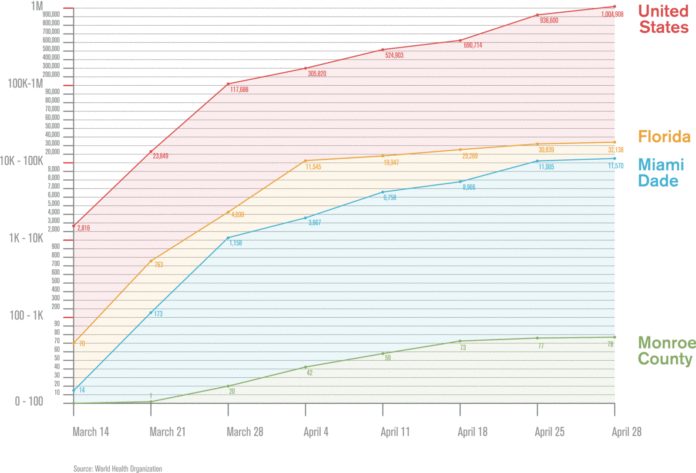
From the local level to the state, task force groups are forming to examine reopening plans and the easing of restrictions, which have been in place for some time to combat a serious coronavirus pandemic and crush an upward swing in positive cases.
Members of the task forces are about to face a momentous task, as pleas to reopen a bleeding economy grow while reports of positive COVID-19 cases continue. Local parks and beaches are welcoming locals only back, but such reopenings like allowing visitors to the Keys and other major tourist attractions in the state will likely hinge on a continued downward spiral in new cases.
County officials have said that two weeks of no cases must be witnessed before the flow of visitors comes back to the island chain.
So, what’s key in making these major determinations? Data. Those throughout the state working to gauge the magnitude of the pandemic need to break down pieces of information, like testing numbers, which are taken with a grain of salt since roughly 1.4% of the Florida population has been tested — 1.6% in Monroe County. Other data, such as those who have recovered from COVID-19, isn’t being tracked.
CASE UPDATES NOW ONCE A DAY, AND A NEW COUNTY REPORT
COVID-19 cases were formerly updated two times a day — one in the late morning and the other late afternoon. Numbers of those tested and new cases fluctuated once or twice daily, a byproduct of labs issuing results.
On April 25, the health department announced that dashboard figures and a lengthy state report are being updated once per day. And with a change in the reporting comes the addition of a comprehensive county-by-county report. Visiting the Florida Health Department’s COVID-19 page at floridahealthcovid19.gov, users can delve a little deeper into the number of positive and negative cases over the last two weeks, cases by ethnicity, percentage of positive cases and emergency department admission percentages for common symptoms of coronavirus: shortness of breath, fever or cough.
As the Centers for Disease Control and Prevention announced April 27, six new symptoms are being added to its existing list for COVID-19: chills, repeated shaking with chills, muscle pain, headache, sore throat or loss of taste or smell. That could bring some new visits.
POSITIVE CASES IN THE COUNTY
• The first case was reported on March 20.
• On March 31, the percentage of tests coming back positive peaked at 14%.
• Positive percentages started declining, from 10% on April 7 to 8% on April 14, 7% on April 21 and April 26.
• As of April 28, the county reported 78 cases. The day before it was 79, but investigation revealed that one of those was from a different county.
Has Monroe County flattened the curve? Drops in percent positives appears to show that, in terms of the percentage of cases testing positive in the weeks after March 31. Those testing positive for COVID-19 overall were 8.9% statewide as of April 26.
The county last saw saw a noticeable jump in cases, five, from 68 on April 17 to 73 on April 18. Days passed, however, with no new cases, until one positive was reported on April 23, then three on April 24 and one between April 25 and 27, bringing the total to 78. Was it a matter of the county health department waiting on tests from labs? Or were tests coming back negative?
In that span of no new reported cases, April 19 to April 23, 104 new test results were reported. Of those, 103 came back negative and one positive.
In the state, confirmed cases among Floridians reached 31,986 and 860 non-Florida residents as of April 28. Roughly 1 in 700 Floridians have been infected. The number of cases reflects the total over time from when the first case hit the state in early March. That means a number of these cases have entered recovery, but that number isn’t being tracked (more on that later).
On April 27, the health department reported a new case to bring the number to 79. The next day, however, the case count dropped back to 78. The health department attributed the drop in case numbers to an address that was given at the time of testing that showed the Florida resident wasn’t from Monroe County. Upon investigation, it’s sometimes realized that the person may have used a post office box instead of a home address, the health department said. It could be a second-home address and not the primary residential address. Or, the person could have been visiting. The data will continue to change as needed to ensure it’s as accurate as possible, the health department said.
TESTING… WHERE ARE WE WITH IT?
• As of April 28, a total of 1,179 were tested in Monroe County. Of those, 1,101 were negative and 78 positive. The health department was awaiting results on 23 tests.
• With a population of around 74,200, about 1.6% of county residents have been tested so far.
• Statewide, a total of 367,435 tests have been conducted, or a little more than 1.7% of the population, as of April 28.
New tests conducted by week
(Florida Health Department)
• March 31-April 7: 273
• April 7-14: 300
• April 14-21: 197
• April 21-28: 203
Some 200 to 300 new tests were conducted per week from the end of March to mid-April. The latter half of April has seen around 200 tests conducted per week. Per Bob Eadie, health officer for Monroe County, logistics are improving and more test kits are coming into Monroe County.
Keep in mind that a little over 1% of the population has been tested in Monroe County. It’s unknown how many will be tested. But data has shown that a majority of the tests are coming back negative.
Based on the level of current testing, however, Dr. Aileen Marty, infectious disease expert at Florida International University, said there must be strict rules in place to maintain social distancing if communities start to open up in a limited way.
“When we have the right testing, when we start testing every contact of every positive person and every symptomatic person and properly isolating them … and we have a community that is ready psychologically to understand if we open up slowly, we have to really seriously understand these social distances have to be maintained until we can get there,” she said.
Statewide, tests that were conducted daily were hovering around 12,000 the past several weeks. That number has since increased to about 15,000 per day in the last week or so. On April 25, results of more than 19,000 tests were received — the second most since testing began.
With nasal swabs to determine if a person has the virus, there’s also testing to see whether people have developed antibodies. Doctors from Key West to Key Largo are beginning to administer those. (Check with your doctor.)
Key West physician John Norris took to Facebook on Monday and showed that four negative COVID-19 tests came back from people who thought or believed they had been sick with the virus in the past.
“The people I’ve tested who I knew had COVID came back positive for antibodies,” he said. “People who thought they were sick? Nope. Tested a few of those too.”
A Key West partnership is finalizing plans to roll out a massive effort to test thousands of residents for COVID-19 and the associated antibodies that provide evidence of a past infection. Key West’s One Clean Island committee, in partnership with Dr. Bruce Boros and Advanced Urgent Care, performed 10 preliminary rapid-result, finger-stick antibody tests on Monday afternoon, April 27, at Two Friends Patio Restaurant.
The One Clean Island committee sponsored the first round of test kits and is now working on securing a much larger order of 10,000 or so kits and establishing multiple testing sites for Key West residents.
“Hopefully, that will be done through a public-private partnership for the massive testing effort,” Boros said. “These testing capabilities will allow us to have specific knowledge about our population and eventually our arriving visitors, once we open the Keys.”
HOW MANY HAVE RECOVERED?
That figure remains elusive in Florida, as daily reports and dashboard updates don’t say how many are back to being healthy after a battle with COVID-19. Eadie told county officials in early April that the health department isn’t tracking that information.
“Part of it is we just don’t have the staff to get it done,” he said. “Tallahassee is trying to find a program to do that. Right now, we’re stretched pretty thin.”
The state health office in Tallahassee further explains why it doesn’t measure recovery and doesn’t expect to have such a designation anytime soon.
“Currently, there are multiple ways for recovered cases to be recorded, and several methods are used by different countries and states,” the health department says. “Some states and countries measure a case as recovered when a person has had COVID-19 for more than 14 days, while others upon hospital discharge data — neither of which completely capture recovery of the full COVID positive population. The Florida Department of Health will continue to provide information on hospitalizations and deaths to keep the public informed about the threat of the virus.”
HOSPITALIZATIONS
Nine county residents and two nonresidents have been hospitalized for coronavirus since the pandemic began. That’s 13% of all cases. Statewide, 16% of cases were hospitalized.
Hospitalization counts include anyone who was hospitalized at some point during their illness. It does not reflect the number of people currently hospitalized.
No one was hospitalized in the county with COVID-19 as of April 30, per officials.
Dr. Tom Morrison, emergency room director at Mariners and Fishermen’s hospitals, told the Weekly on April 28 that he personally hasn’t seen any COVID-19-related hospitalizations for the past 11 days. All tests sent out by the hospitals in the last two weeks have come back negative, he said.
“The ones I saw over the past three weeks got to go home and get better,” he said. “I think we’re definitely at the other side of this, which is good.”
Morrison said resurgence in communities that could be seen when reopenings begin is because “people who are carriers who don’t know they’re carriers are exposed to people who haven’t been exposed.”
“That’s going to happen, but it’s going to happen to a very, very small extent. I don’t believe it’s going to be as overwhelming as suggested,” he said.
THE OUTLOOK
Locally, residents are urged to continue their social distancing and practice protective measures to prevent any potential spread of the coronavirus. Meanwhile, Eadie and county officials are keeping a close eye on what’s happening in neighboring counties.
“We want to be sure they won’t have any adverse effects here in Monroe County. I think the informational checkpoint has done a great deal to keep infection out of the Florida Keys,” he said. “The worst thing we could do is to reintroduce infections to the Keys and have to do this all over again. That would be devastating. If we do our jobs correctly, we won’t see any high spikes of infection that other places have dealt with.”






















